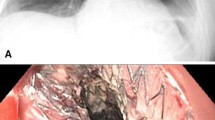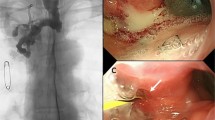Abstract
Background
Dedicated stents for treatment of cervical anastomotic leakage are currently unavailable. In this study, we aimed to assess the feasibility and efficacy of using custom-designed stents for treatment of cervical anastomotic leakage after esophagectomy.
Methods
The stents were designed according to the location and size of the leakage and the residual esophageal length as determined by esophagography in each case. It had a cup-shaped upper end and a globular lower end and a total height of 60–85 mm. The diameter of the upper cup-shaped part was 24–26 mm and the length 20–25 mm. The cup part and the stent main body were connected at a right angle. Data from cervical anastomotic leakage patients treated with these stents were retrospectively analyzed.
Results
Data from a total of 27 patients with cervical anastomotic leakage were retrospectively analyzed. The custom-designed esophageal covered stents were placed successfully at the first attempt in 24 cases (88.9%). The total operative time was 5–15 min. The stents were removed 7 days to 3 months after leakage healing. Follow-up showed no leakage recurrence; three patients had anastomosis scar strictures. Fifteen patients died (median survival 13.4 months) and nine survived.
Conclusion
Placement of the novel esophageal covered stent is a minimally invasive, efficacious treatment option for the patients with cervical anastomotic leakage after esophagectomy.



Similar content being viewed by others
References
Kassis ES, Kosinski AS, Ross P Jr, Koppes KE, Donahue JM, Daniel VC (2013) Predictors of anastomotic leak after esophagectomy: an analysis of the society of thoracic surgeons general thoracic database. Ann Thorac Surg 96:1919–1926
Kayani B, Jarral OA, Athanasiou T, Zacharakis E (2012) Should oesophagectomy be performed with cervical or intrathoracic anastomosis? Interact Cardiovasc Thorac Surg 14:821–827
Brinster CJ, Singhal S, Lee L, Marshall MB, Kaiser LR, Kucharczuk JC (2004) Evolving options in the management of esophageal perforation. Ann Thorac Surg 77:1475–1483
Minnich DJ, Yu P, Bryant AS, Jarrar D, Cerfolio RJ (2011) Management of thoracic esophageal perforations. Eur J Cardiothorac Surg 40:931–937
Leers JM, Vivaldi C, Schäfer H, Bludau M, Brabender J, Lurje G, Hölscher AH, Metzger R (2009) Endoscopic therapy for esophageal perforation or anastomotic leak with a self-expandable metallic stent. Surg Endosc 23:2258–2262
Han X, Zhao YS, Fang Y, Qi Y, Li X, Jiao D, Ren K, Wu G (2016) Placement of transnasal drainage catheter and covered esophageal stent for the treatment of perforated esophageal carcinoma with mediastinal abscess. J Surg Oncol 114:725–730
Gang W, Zhao YS, Fang Y, Qi Y, Li X, Jiao D, Ren K, Han X (2017) Treatment of spontaneous esophageal rupture with transnasal thoracic drainage and temporary esophageal stent and jejunal feeding tube placement. J Trauma Acute Care Surg 82(1):141–149
D’Cunha J, Rueth NM, Groth SS, Maddaus MA, Andrade RS (2011) Esophageal stents for anastomotic leaks and perforations. J Thorac Cardiovasc Surg 142:39–46
Rajan PS, Bansal S, Balaji NS, Rajapandian S, Parthasarathi R, Senthilnathan P, Palanivelu C (2014) Role of endoscopic stents and selective minimal access drainage in oesophageal leaks: feasibility and outcome. Surg Endosc 28:2368–2373
Freeman RK, Ascioti AJ, Giannini T, Mahidhara RJ (2012) Analysis of unsuccessful esophageal stent placements for esophageal perforation, fistula, or anastomotic leak. Ann Thorac Surg 94:959–965
van Halsema EE, van Hooft JE (2015) Clinical outcomes of self-expandable stent placement for benign esophageal diseases: a pooled analysis of the literature. World J Gastrointest Endosc 7:135–153
Bège T, Emungania O, Vitton V, Ah-Soune P, Nocca D, Noël P, Bradjanian S, Bradjanian S, Berdah SV, Brunet C, Grimaud JC, Barthet M (2011) An endoscopic strategy for management of anastomotic complications from bariatric surgery: a prospective study. Gastrointest Endosc 73:238–244
Winder JS, Pauli EM (2015) Comprehensive management of full-thickness luminal defects: the next frontier of gastrointestinal endoscopy. World J Gastrointest Endosc 7:758–768
Acknowledgements
This research did not receive any specific grant from any funding agency in the public, commercial, or not-for-profit sector. We thank the Nanjing Micro-Tech Medical Company for kindly providing the novel esophageal stents.
Author information
Authors and Affiliations
Corresponding author
Ethics declarations
Disclosures
Drs. Gang Wu, Meipan Yin, Yan Shi Zhao, Yi Fang, Yu Qi, Xiangnan Li, and Xinwei Han have no conflicts of interest or financial ties to disclose.
Rights and permissions
About this article
Cite this article
Wu, G., Yin, M., Zhao, Y.S. et al. Novel esophageal stent for treatment of cervical anastomotic leakage after esophagectomy. Surg Endosc 31, 5024–5031 (2017). https://doi.org/10.1007/s00464-017-5545-6
Received:
Accepted:
Published:
Issue Date:
DOI: https://doi.org/10.1007/s00464-017-5545-6




